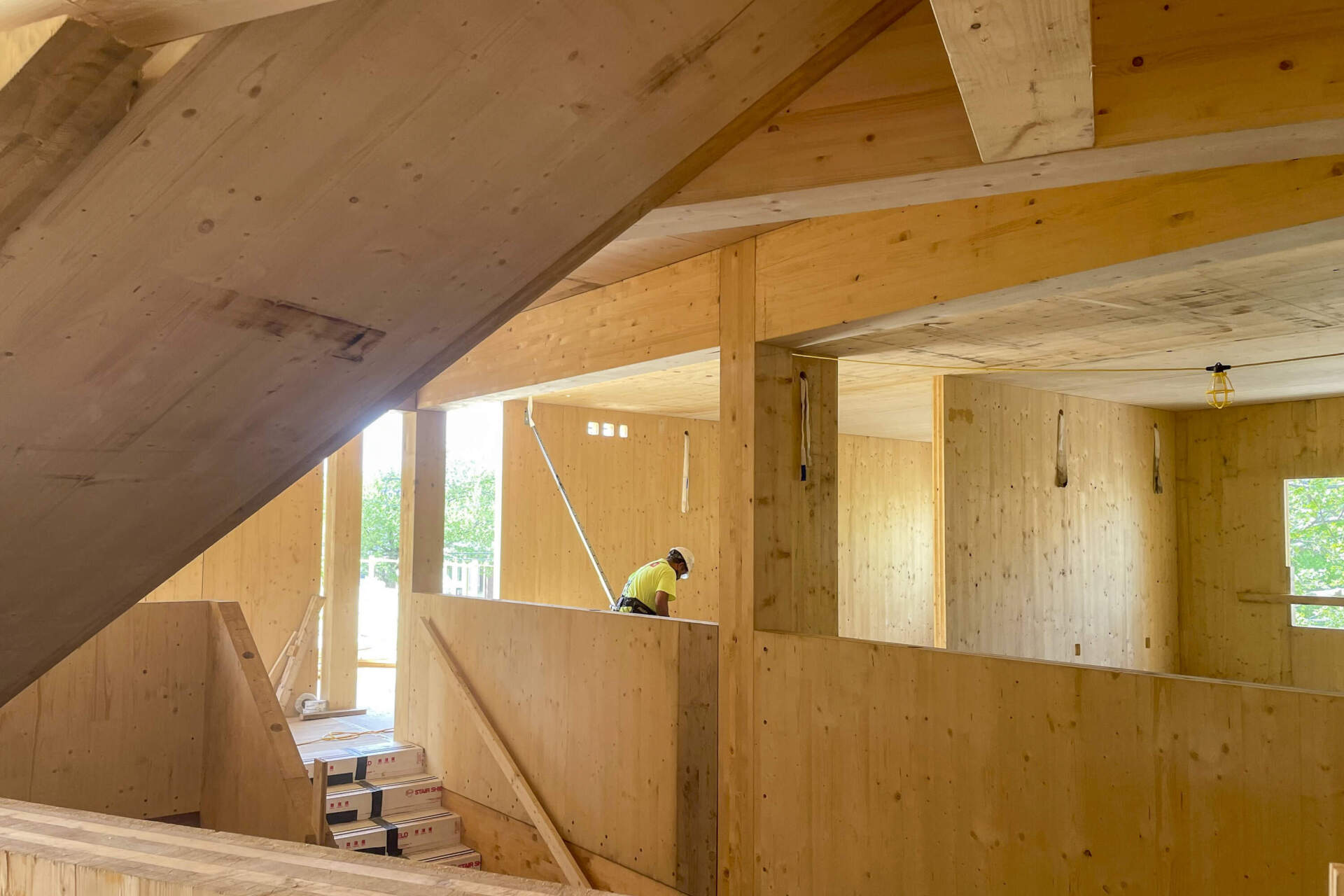Buildings are a big part of New England’s emissions. States are working to change that
Buildings are a big part of New England's emissions. States are working to change that WBUR News


Reducing Fossil Fuel Use in New England Buildings
As New England moves to drastically reduce its carbon footprint, one of the big fossil fuel uses it must address is its buildings. The region’s homes and buildings are the second-largest emitter, falling just behind transportation; buildings emit around one-third of states’ planet-warming emissions.
That’s in part because New England housing stock tends to be older, poorly insulated and less efficient. In Maine for example, more than half the homes were built before 1980 and 61% of Maine homes use fuel oil for heat. Buildings in the Northeast require significant heating — and will increasingly require more cooling as summers continue to warm.
The burden of updating a home typically falls on the homeowner but some states are moving forward with incentives, updated building codes and pilot projects to jumpstart decarbonization in existing homes. And municipalities and developers alike are exploring ways to construct new homes with significantly lower carbon footprints — everything from using greener building materials to electrifying the way homes heat and cool.
Building new homes to be more climate-friendly
The good news is that there are a lot more innovative options for building more efficient and climate-friendly homes. One building technique that is gaining some traction is what’s known as the “passive house” technique— it entails insulating the home to be nearly airtight with thicker walls and windows, as well as siting the home to take advantage of natural heat from the sun. Read more about one Maine family’s experience living in a passive home, where their heat and electricity costs were about $13 a month during the winter. The technique is even more economically viable for multi-unit buildings like this one in Boston.
The building materials themselves also have a climate footprint. That’s why some are experimenting with a form of composite wood that can reduce greenhouse gas emissions and drastically lower waste. Called “mass timber,” it can be made into large slabs that can match or exceed the performance of concrete and steel, and it’s been used in some new affordable housing. Habitat for Humanity has also begun building some near net-zero homes in Connecticut, which cost about 10% more than a fossil-fuel-based home.

Home demolition contributes to emissions, too: 40% of the volume of our landfills are waste from construction and demolition, according to Felix Heisel, who teaches architecture and directs the Circular Construction Lab at Cornell University. That’s why two women in Cape Cod have formed their own company to salvage and repurpose parts from homes being demolished. Since founding WasteNot in 2017, the company estimates it has diverted from landfills more than an acre of hardwood flooring, roughly 570 kitchen cabinets, and 500 windows.
Where we choose to build our homes also matters — New England has thousands of miles of coastline and with rising sea levels, not all those beautiful locations are viable for supporting homes.
Greening up older buildings
Much of New England’s urban population lives in aging multi-family homes — Boston, for one, has nearly 10,000 three-deckers — which present their own unique challenges to green up. Some companies have begun that work, doing what’s known as a “deep energy retrofit” for Mass. triple-deckers: insulating the building by sealing off air leaks and installing more sophisticated HVAC systems —and in some cases, installing solar panels.
Other entrepreneurs are tackling even older buildings. Students in New Bedford, are working to transition an old firehouse into a climate-friendly apartment building. And this Portsmouth house built in 1750
SDGs, Targets, and Indicators
SDGs Addressed:
- SDG 7: Affordable and Clean Energy
- SDG 9: Industry, Innovation, and Infrastructure
- SDG 11: Sustainable Cities and Communities
- SDG 12: Responsible Consumption and Production
- SDG 13: Climate Action
Targets Identified:
- Target 7.2: Increase substantially the share of renewable energy in the global energy mix
- Target 9.4: Upgrade infrastructure and retrofit industries to make them sustainable
- Target 11.2: Provide access to safe, affordable, accessible, and sustainable transport systems for all
- Target 12.2: Achieve sustainable management and efficient use of natural resources
- Target 13.2: Integrate climate change measures into national policies, strategies, and planning
Indicators:
- Indicator 7.2.1: Renewable energy share in the total final energy consumption
- Indicator 9.4.1: CO2 emissions per unit of value added
- Indicator 11.2.1: Proportion of population that has convenient access to public transport
- Indicator 12.2.1: Material footprint, material footprint per capita, and material footprint per GDP
- Indicator 13.2.1: Number of countries that have communicated the strengthening of institutional, systemic, and individual capacity-building to implement adaptation, mitigation, and technology transfer
Table: SDGs, Targets, and Indicators
| SDGs | Targets | Indicators |
|---|---|---|
| SDG 7: Affordable and Clean Energy | Target 7.2: Increase substantially the share of renewable energy in the global energy mix | Indicator 7.2.1: Renewable energy share in the total final energy consumption |
| SDG 9: Industry, Innovation, and Infrastructure | Target 9.4: Upgrade infrastructure and retrofit industries to make them sustainable | Indicator 9.4.1: CO2 emissions per unit of value added |
| SDG 11: Sustainable Cities and Communities | Target 11.2: Provide access to safe, affordable, accessible, and sustainable transport systems for all | Indicator 11.2.1: Proportion of population that has convenient access to public transport |
| SDG 12: Responsible Consumption and Production | Target 12.2: Achieve sustainable management and efficient use of natural resources | Indicator 12.2.1: Material footprint, material footprint per capita, and material footprint per GDP |
| SDG 13: Climate Action | Target 13.2: Integrate climate change measures into national policies, strategies, and planning | Indicator 13.2.1: Number of countries that have communicated the strengthening of institutional, systemic, and individual capacity-building to implement adaptation, mitigation, and technology transfer |
Analysis:
The issues highlighted in the article are connected to several Sustainable Development Goals (SDGs). The main SDGs addressed are SDG 7 (Affordable and Clean Energy), SDG 9 (Industry, Innovation, and Infrastructure), SDG 11 (Sustainable Cities and Communities), SDG 12 (Responsible Consumption and Production), and SDG 13 (Climate Action).
Based on the content of the article, specific targets under these SDGs can be identified:
- Target 7.2: Increase substantially the share of renewable energy in the global energy mix
- Target 9.4: Upgrade infrastructure and retrofit industries to make them sustainable
- Target 11.2: Provide access to safe, affordable, accessible, and sustainable transport systems for all
- Target 12.2: Achieve sustainable management and efficient use of natural resources
- Target 13.2: Integrate climate change measures into national policies, strategies, and planning
The article also mentions or implies indicators that can be used to measure progress towards the identified targets:
- Indicator 7.2.1: Renewable energy share in the total final energy consumption
- Indicator 9.4.1: CO2 emissions per unit of value added
- Indicator 11.2.1: Proportion of population that has convenient access to public transport
- Indicator 12.2.1: Material footprint, material footprint per capita, and material footprint per GDP
- Indicator 13.2.1: Number of countries that have communicated the strengthening of institutional, systemic, and individual capacity-building to implement adaptation, mitigation, and technology transfer
The article provides examples of innovative projects happening across New England to reduce buildings’ reliance on fossil fuels, such as building more climate-friendly homes using passive house techniques, using greener building materials like mass timber, retrofitting older buildings for energy efficiency, and transitioning low-income housing off fossil fuels. These initiatives contribute to the targets mentioned above and can be measured using the corresponding indicators.
Behold! This splendid article springs forth from the wellspring of knowledge, shaped by a wondrous proprietary AI technology that delved into a vast ocean of data, illuminating the path towards the Sustainable Development Goals. Remember that all rights are reserved by SDG Investors LLC, empowering us to champion progress together.
Source: wbur.org

Join us, as fellow seekers of change, on a transformative journey at https://sdgtalks.ai/welcome, where you can become a member and actively contribute to shaping a brighter future.







